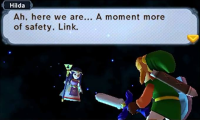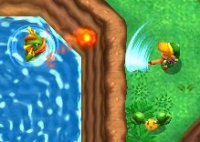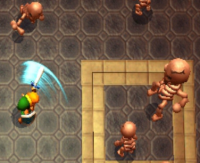The Legend of Zelda: A Link Between Worlds
 There was a lot of smiling happening as I played A Link Between Worlds. When I wasn’t smiling, my eyes were likely glazed over as I stared intently into the dual screens, adventuring through Hyrule and dark counterpart Lorule.
There was a lot of smiling happening as I played A Link Between Worlds. When I wasn’t smiling, my eyes were likely glazed over as I stared intently into the dual screens, adventuring through Hyrule and dark counterpart Lorule.
You could be forgiven if you imagined this love and addiction a product of pure nostalgia bottled into a brand new sixty-frames-per-second cartridge of wonderment. After all, so much of the game looks, plays and sounds exactly like an upgraded remake of a Super Nintendo game would be expected. Yet Nintendo disguised an experiment, a prototype even, of change into this iteration of Zelda. Instead of being a half-assed tech demonstration, however, it plays like everything you’ve ever loved and so much more.
A Link Between Worlds is a sequel to the Super Nintendo classic The Legend of Zelda: A Link to the Past. It takes place some indeterminate number of generations after the SNES game with a different Link and a different Zelda, even though plenty of familiar faces appear. Characters from Ocarina of Time even make an appearance here and there, ensuring a variety of older fans have plenty to smile about. So much of the world of Hyrule is the same as it was in the 16-bit era, with minor changes and modifications to secret locations and tools.
There are two big changes this time, however. Instead of relying on a tool such as the ocarina or the Wind Waker wand, or being able to transform into a wolf, Link is capable of flattening himself against walls. When you become this two-dimensional drawing, you’re suddenly able to travel across gaps, around pillars, and through a variety of other obstacles that would limit a full, three-dimensional Link’s travel.
The real shift, as subtle as it may be, is the ability to rent and purchase Link’s inventory instead of slowly gaining the tools over time. At first this seems like a bad idea, as if they’re removing the actual satisfaction in obtaining the bow, the hookshot, or the fire rod.
 Instead, the world is opened up to Link and, by extension, the player. Rupees are suddenly valuable, and hacking through bushes and pots for money is a necessity rather than some bad OCD-level habit. The player is free to explore the world and figure out secrets and puzzles all at once, only increasing the sense of accomplishment, productivity, and satisfaction in snagging yet another piece of heart. Chests of rupees are no longer a disappointment as they get you one step closer to purchasing an expensive item or upgrade. Each labyrinth is now built completely around puzzles, shifting the focus from navigating the environment until you have the necessary item to solving one puzzle to the next. It’s the same sort of addictive energy gained from a title like Portal, only the transitions here are seamless. Figure out how to reach that platform, and now boggle over how to access that switch over there.
Instead, the world is opened up to Link and, by extension, the player. Rupees are suddenly valuable, and hacking through bushes and pots for money is a necessity rather than some bad OCD-level habit. The player is free to explore the world and figure out secrets and puzzles all at once, only increasing the sense of accomplishment, productivity, and satisfaction in snagging yet another piece of heart. Chests of rupees are no longer a disappointment as they get you one step closer to purchasing an expensive item or upgrade. Each labyrinth is now built completely around puzzles, shifting the focus from navigating the environment until you have the necessary item to solving one puzzle to the next. It’s the same sort of addictive energy gained from a title like Portal, only the transitions here are seamless. Figure out how to reach that platform, and now boggle over how to access that switch over there.
There are still new tools to discover within the dungeons and areas locked away until the player progresses just far enough. How long these passages and secrets remain hidden or sealed away is completely dependent upon the player, as they can complete the dungeons in any order desired.
If anything, A Link Between Worlds feels a lot more like the original Legend of Zelda with the new gameplay improvements and features found in A Link to the Past. While there is an intended order to complete each of the dungeons, or some are simply easier than others, there is no one true way to progress through.
Perhaps the greatest change in A Link Between Worlds is how capable the game treats the player. The opening may feel a bit slow, but this is primarily due to introducing the story and goals rather than any lengthy tutorial. Once the first dungeon has been completed and Link has been set on his task, he is alone. No fairy, no sentient ship, no construct to guide and inform the player at every turn. Hint glasses are provided, certainly, but otherwise the game just expects the player to explore and figure things out at their own pace.
 Once entering the dark world of Lorule, the game takes a significant increase in difficulty as well. Exploration is risky at first as foes take multiple hearts of health in a single strike. There are secrets around every corner, but danger lurks closely behind. Purchasing weapons is of greater importance, as you lose any rented item upon death. So sure, you may have everything at once, but one false step and a collection of empty bottles later, and they all go back to the shop.
Once entering the dark world of Lorule, the game takes a significant increase in difficulty as well. Exploration is risky at first as foes take multiple hearts of health in a single strike. There are secrets around every corner, but danger lurks closely behind. Purchasing weapons is of greater importance, as you lose any rented item upon death. So sure, you may have everything at once, but one false step and a collection of empty bottles later, and they all go back to the shop.
A Link Between Worlds acknowledges that danger and risk engage the player, and as a result are a necessary element of fun. It does not treat them as if they are an idiot, but rather that exploration and discovery are the purpose they are playing. As such, the focus is shifted away from hiding tools within dungeons to theming dungeons around collections of tools. The world is opened up to the player all at once. All the classic Zelda gameplay is there, improved in some ways and shifted just enough in others to provide emphasis on why you’re really there.
Exploring Hyrule has never been so fun or addicting. I think, after almost twenty years, I finally have a new favorite Zelda game.


